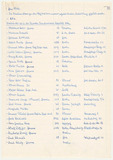Wooden toys by Schwerin Woodworks
Wooden toys by Schwerin Woodworks
… wir zogen es aus politischen und persönlichen gründen vor, unsere berufe aufzugeben und als handwerker zu arbeiten. wir bauten aus ganz kleinen anfängen eine werkstatt auf für holzspielsachen und kunstgewerbe. in krisenzeiten, und deren gab es manche, fabrizierten wir wirtschaftsartikel. wir hatten grosse freude an unserer arbeit, und oft fiel uns auf, wie vieles, was wir taten, auf den bauhauseinfluss zurückzuführen war. ausserdem verschaffte uns diese arbeit eine grosse unabhängigkeit, die wir brauchten um hier leben zu können, da wir nicht als zionisten nach palästina kamen, sondern aus mangel an anderen möglichkeiten.
[...for political and personal reasons, we preferred to give up our professions and work as craftsmen instead. from very modest beginnings, we built a workshop for wooden toys and arts and crafts. in times of crisis – and of those there were many – we fabricated commodities. we took great joy in our work, and we often noticed how much of what we did was influenced by the bauhaus school. this work also gave us a great sense of independence, which we needed to live here since we did not come as zionists to palestine, but rather for a lack of other options. (ed. trans.)]
Letter from Ricarda Schwerin to Hannes Meyer, 4 March 1948
After running out of options, Ricarda Schwerin and Heinz Schwerin emigrated to Palestine in 1935, even though they were not Zionists and Ricarda was not Jewish. The couple settled in Jerusalem and, after a difficult early phase, founded the Schwerin Wooden Toys workshop for the production of wooden toys. In the years that followed, what emerged was an entire collection of solid-wood toys that explicitly followed the design and production principles of the Bauhaus movement. In 1937, several exhibits were held at the Pavillon d'Israël en Palestine at the World Fair in Paris, and the press in Palestine praised the couple as “pioneers of wooden toys in Palestine”. Heinz Schwerin also designed numerous pieces of furniture, several of which were collaborative works created with his former Bauhaus peer Selman Selmanagic.
Stiftung Bauhaus Dessau





